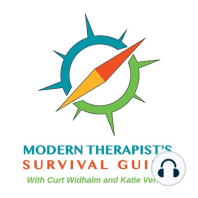33 min listen

Are You Burned Out or Are You Bored?
FromThe Modern Therapist's Survival Guide with Curt Widhalm and Katie Vernoy
Are You Burned Out or Are You Bored?
FromThe Modern Therapist's Survival Guide with Curt Widhalm and Katie Vernoy
ratings:
Length:
36 minutes
Released:
Mar 18, 2024
Format:
Podcast episode
Description
Are You Burned Out or Are You Bored?
Curt and Katie chat about another type of burnout, “bore out.” We explore the difference between burnout and boredom. We talk about what might be unique to therapists’ jobs that would lead to boredom. We also dig into how dissociation can show up as either burnout or boredom. Finally, we share ideas on how modern therapists can mitigate some of the impacts of burnout, boredom, and vicarious trauma.
Transcripts for this episode will be available at mtsgpodcast.com!
In this podcast episode we talk about both burnout and “bore out”
Katie has been feeling a little bit bored lately, so she decided to do some research on what might be happening. She uncovered a concept “bore out” which seems to be the opposite of burnout, but with similar consequences. We decided to dig into this topic to see what therapists can do to try to avoid (or address) burnout.
What are the differences between burnout and boredom?
· Burnout is overstimulation to the point of running out of energy
· Boredom is under-stimulation to the point of lack of creativity and stagnation
· Burnout is a pretty common topic, but “bore out” never really took off
· People more likely to leave a job due to boredom
What are the types of boredom that therapists face?
· Clinical boredom (repeated stories, lack of progress)
· Repetitive clinical work (due to niche, evidence-based practice)
· Notes and documentation are frequently described as boring
· Trauma therapists may become cynical
· Vicarious trauma, compassion fatigue and moral injury
· Desensitization and disengagement of vicarious trauma can feel like boredom
· Dissociation may also be part of this disengagement
What can therapists do to address boredom?
· Clinical consultation and your own therapy
· Professional development and continuing education
· Refreshing your knowledge and bringing new techniques into session
· Adequate stimulation to get work done
· Doing things in small doses
· Reframing things to make them more positive (not “onerous” or “boring”)
Stay in Touch with Curt, Katie, and the whole Therapy Reimagined #TherapyMovement:
Our Linktree: https://linktr.ee/therapyreimagined
Modern Therapist’s Survival Guide Creative Credits:
Voice Over by DW McCann https://www.facebook.com/McCannDW/
Music by Crystal Grooms Mangano https://groomsymusic.com/
Curt and Katie chat about another type of burnout, “bore out.” We explore the difference between burnout and boredom. We talk about what might be unique to therapists’ jobs that would lead to boredom. We also dig into how dissociation can show up as either burnout or boredom. Finally, we share ideas on how modern therapists can mitigate some of the impacts of burnout, boredom, and vicarious trauma.
Transcripts for this episode will be available at mtsgpodcast.com!
In this podcast episode we talk about both burnout and “bore out”
Katie has been feeling a little bit bored lately, so she decided to do some research on what might be happening. She uncovered a concept “bore out” which seems to be the opposite of burnout, but with similar consequences. We decided to dig into this topic to see what therapists can do to try to avoid (or address) burnout.
What are the differences between burnout and boredom?
· Burnout is overstimulation to the point of running out of energy
· Boredom is under-stimulation to the point of lack of creativity and stagnation
· Burnout is a pretty common topic, but “bore out” never really took off
· People more likely to leave a job due to boredom
What are the types of boredom that therapists face?
· Clinical boredom (repeated stories, lack of progress)
· Repetitive clinical work (due to niche, evidence-based practice)
· Notes and documentation are frequently described as boring
· Trauma therapists may become cynical
· Vicarious trauma, compassion fatigue and moral injury
· Desensitization and disengagement of vicarious trauma can feel like boredom
· Dissociation may also be part of this disengagement
What can therapists do to address boredom?
· Clinical consultation and your own therapy
· Professional development and continuing education
· Refreshing your knowledge and bringing new techniques into session
· Adequate stimulation to get work done
· Doing things in small doses
· Reframing things to make them more positive (not “onerous” or “boring”)
Stay in Touch with Curt, Katie, and the whole Therapy Reimagined #TherapyMovement:
Our Linktree: https://linktr.ee/therapyreimagined
Modern Therapist’s Survival Guide Creative Credits:
Voice Over by DW McCann https://www.facebook.com/McCannDW/
Music by Crystal Grooms Mangano https://groomsymusic.com/
Released:
Mar 18, 2024
Format:
Podcast episode
Titles in the series (100)
Vulnerability, Mistakes, and The Impostor Syndrome: How to navigate through being a human being AND a therapist (at the same time) by The Modern Therapist's Survival Guide with Curt Widhalm and Katie Vernoy